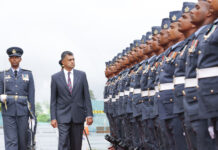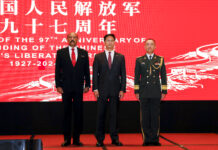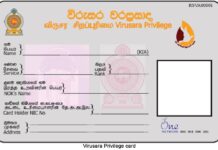Compiled By: Gp Capt Kumar Kirinde, SLAF (Retd)
Contents totally based on information shared by Henrik Melder, Aviation and
General History Enthusiast
The year was 1944 and Sri Lanka (then Ceylon) was caught in the vortex of World War II, which had by then entered its fifth year. Around this time, a Japanese submarine set off from Penang (in Japanese-occupied Malaya) carrying four young Sri Lankans. They were Tudor Gunaratne, Vernon Fernando and two brothers, Edwin and Joseph Jayakody. They were supposed to land off Kirinda on this country’s southern coast. From there the four young men were to operate a secret radio transmitter to report on security forces operations here. The objective was to facilitate Tokyo’s invasion plans for India and Sri Lanka. This island then was the hub of Allied (AngloAmerican) military, naval and air operations in the context of the world war.
But by some quirk of fate, the submarine dropped them off South India’s Madras coast, where they were caught by the British and executed. The unfortunate Sri Lankans were members of the ‘Hikari Kikan.’* This special Japanese agency recruited Sri Lankans, Indians and other south Asians domiciled in Malaya and Singapore for spying missions against the Allies. However, it is believed that Allied secret agents operating in Japanese-occupied territory had tipped off the British on the enemy spies. Six other Sri Lanka ‘Hikari Kikan’ members, Christie Seneviratne (later Sports Editor, ‘Daily News’),
Samson Silva, Henry Tissa, Lionel Hettihewa and Piyasena, Dayananda avoided going on the fateful mission at the 11th hour. Christie and Samson however had to pay the penalty for “wasting the time, money and energy of the Japanese Imperial Army,” in the words of the Japanese Officer-in-Charge, Hayashi. Consequently, the two young men suffered imprisonment, until they were rescued by the British, after the Japanese surrender… – “FOUR LANKANS DIE IN SECRET ‘INDEPENDENCE’ WAR” by Janaka Perera. (http://www.lankalibrary.com/geo/japan3.htm)
* The Hikari Kikan was the Japanese liaison office responsible for Japanese relations with the Azad Hind Government. It recruited Sri Lankans, Indians and other South Asians domiciled in Malaya and Singapore for spying missions against the Allies. Azad Hind or the Provisional Government of Free India (Arzi Hakumat-e-Azad Hind) was established in Japanese occupied Singapore during World War II. It was created in October 1943 and supported by – as well as largely dependent on – the Empire of Japan. Founded on 21 October 1943, Azad Hind government was inspired by the concepts of Subhas Chandra Bose who was also the leader of the government and Head of State.
Sources: https://en.wikipedia.org/wiki/Hikari_Kikan and https://en.wikipedia.org/wiki/Azad_Hind
THE STORY
The events that led to their deaths and imprisonment go back to February 15, 1942. On that day, the dream life of the British Raj – tennis, cricket, horse racing, afternoon tea parties and nightly dances at Singapore’s Raffles Hotel – ended abruptly as Japan’s Samurai warriors surged down the Malay Peninsula. Singapore – the city of a million neon lights and swinging night life was plunged in darkness as Japanese aerial bombs knocked out the city’s power supply. Caught up in this fateful turn of events were many Sri Lankans who had migrated to what was then the Federated States of Malaya (which included Singapore) in search of greener pastures. Among them were Lionel Hettihewa, Samson Silva, Christie Seneviratne (later Sports Editor Daily News), Edwin Jayakody and his brother Joseph. The two brothers had migrated to Malaya as small boys with their parents in 1932.
The economic chaos in the immediate aftermath of the Japanese military occupation hit the
young Sri Lankans hard and they were ready to take up any job to survive. To their surprise they soon found employment in what was ostensibly a commercial establishment in Penang – 500 miles away from Singapore. They had no idea that this `commercial establishment’ was really the Hikari Kikan – an espionage outfit of the Japanese Imperial Armed Forces.
So the young men – unaware of what was in store of them – were delighted when the Japanese placed a bungalow with a tennis court and a swimming pool at their disposal. One morning Hayashi, a Japanese officer in charge of the Sri Lankan Group took them along to see Iguchi, the Commander of the Japanese Naval Unit in Penang, which was an important base for both Japanese and German Naval craft operating in the Indian Ocean.
Iguchi told the Sri Lankans that they were to be entrusted with a highly confidential and vital task. But to get on with it, the Japanese needed more Sri Lankans – at least eight of them. So Lionel, Samson, Edwin and Christie combed virtually the entire Malay Peninsula in search of fellow countrymen. Eventually they succeeded in rounding up Tudor Gunaratne, Henry Tissa, Vernon Fernando, Chandra Fernando, Piyasena and Dayananda. After a month’s relaxation, the Sri Lankans were ordered to prepare for training. Their work
commenced at 6.00 a.m. Following physical exercise they were given swimming lessons at sea. After lunch they were trained in radio communication. The young trainees were provided with radio transmitting sets and small boats that could be dismantled or assembled at short notice. The Sinhala youths were taught to speak Japanese and training continued until mid-1943. At the end of the period they could handle firearms expertly. A car that once belonged to a British official was placed at their disposal.One night at an ill-lit (because of wartime blackout) dancing club, a Japanese officer introduced
Christie to a German Naval officer, who told the Sri Lankan that an Axis (German, Italian and Japanese) victory in the world war would be the first step towards winning freedom for India and Sri Lanka (then Ceylon) from British rule. By this time Tokyo was propagating the concept of Asia for Asians and a Greater East-Asia Co-prosperity Sphere to win over the natives in Asia’s European colonies.
All this fired the imagination of the Sri Lankans training under the Japanese Forces. However as their training intensified some of the trainees began to have misgivings about the entire operation. They had secretly come to know that the tide of war was turning against Japan, which had suffered heavy naval losses in the battles of the Coral Sea and Midway. The first to lose enthusiasm was Dayananda who was nearly drowned at sea, while training. But the Sri Lankans realized that it was too late to quit by then.
The shrewd Japanese who had already got wind of this called for a meeting of the Sinhala youths to discuss the problem. Dayananda, Piyadasa, Chandra Fernando and Henry Tissa admitted they were experiencing cold feet. Henry who had initially joined with great enthusiasm had another reason to lose interest. He had fallen in love with a beautiful Eurasian girl in Penang.
The Sri Lankans unwilling to continue with their training were ordered to take an oath of secrecy and sign a document that never would they divulge to anyone the training they had undergone. At that moment the youths felt as if a millstone round their necks was taken off them. The Sri Lankan membership in the Hikari Kikan now dropped to seven. They were Lionel Hettihewa, Christie Seneviratne, Samson Silva, Tudor Gunaratne, Vernon Fernando, Edwin Jayakody and his younger brother Joseph. These trainees were then sent to another camp on a hill top overlooking the Indian Ocean. At the new camp they underwent even more rigorous training that included commando tactics and swimming in turbulent high seas. They were also ordered to study thoroughly Sri Lanka’s geography the knowledge of which was essential for a secret agent operating there. Shortly afterwards the Japanese divulged to the trainees the exact nature of their mission. They were to pass on vital military and naval information to the Japanese from Sri Lanka, which was
then the most vital Allied (British) military base in the Indian Ocean. Its importance was such Allied Forces South East Asia Supreme Commander Admiral Lord Louis Mountbatten transferred his Headquarters from New Delhi to Kandy during the latter part of the world war.
Shortly before the actual operation Hikari Kikan officers ordered a rehearsal in the sea during which the Sri Lankan youths ran into serious trouble with a Japanese Naval unit which did not know anything about the secret operation. The naval personnel mistook the Sri Lankans for Asian members of the British Special Operations Executive (SOE) operating from Sri Lanka to spy on the Japanese. Eventually the young men were released only after Hayashi’s the intervention. He severely reprimanded the Japanese naval guards for detaining the Sri Lankans. After the rehearsals were completed however, the Sri Lankans heard on a secret radio transmitter heavy Japanese battle losses, which had dashed all hopes of victory. It was now 1944 – the year before the war ended. Japan was now waging a bitter back to the wall struggle for survival. Under the circumstances it was sheer lunacy for the Sri Lankans to go on the secret mission for which they had trained. The planned Japanese invasion of Sri Lanka to drive out the British would never come about.
When Christie and Samson conveyed their reluctance to go the mission to Hayashi, the normally soft-spoken Japanese officer growled like a Tiger and his face became livid with rage.
“Not only are you inimical to the Japanese Empire but also you do not want independence for your own country,” he berated. “You spineless cowards. You only want to lick the boots of your white masters. You have wasted the time, money and energy of the Japanese Army. And what is my position? How can I face my superiors? Already arrangements have been made for you to land in Ceylon and now you say this!” The Japanese were however relieved to know that at least four Sri Lankans – the Jayakody brothers, Edwin and Joseph, Tudor Gunaratne and Vernon Fernando were determined to go on the mission. Accordingly, the Japanese made arrangements to take them by submarine and drop them off the coast of Sri Lanka They were to land somewhere in Kirinda and operate a secret radio transmitter from there while monitoring Allied army, navy and air operations in the island.
But unknown to the four young men the British had their own spies in Japanese-occupied Malaya and Singapore.
And by quirk of fate, the Japanese submarine carrying the four Sri Lankans had dropped them off the coast South India, instead of Sri Lanka. It did not take long for the British – who were expecting such enemy infiltration – to capture them. All reports, including an official wartime dispatch from Madras, indicate that they were summarily executed.












